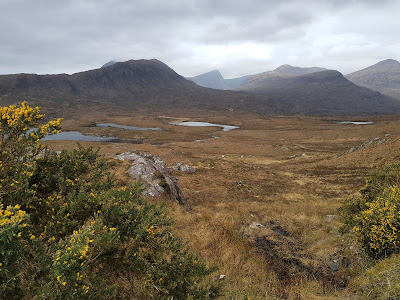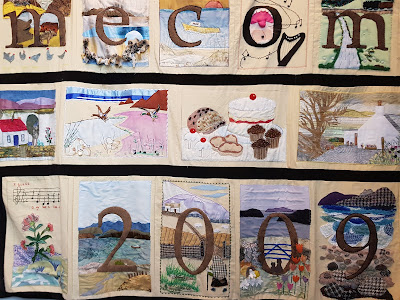Achiltibuie is a northwest-coast Highland village beyond Ullapool. Not very far away from Ullapool as the crow flies, but to
drive there means a long, roundabout journey on a very narrow road. This road is in good condition and isn't difficult; most any kind of vehicle can use it; but the regular need to pull in so that oncoming traffic can pass means that getting to Achiltibuie - and getting away from it - can't be done quickly.
The place is by no means unique on the north-west Scottish coastline for its time-consuming access, but I haven't often driven to somewhere so far from a main road, even in Scotland.
(Click on maps and photos in this post to enlarge the detail)
As you can see from the map just above, Achiltibuie is on the south-west side of the Coigach peninsula, which has the A835 as its base, Loch Sionascaig on its right edge, and the sea on the other two sides, with a scattering of islands offshore, the chief group being the Summer Isles, just across from Achiltibuie itself. The road I've been talking about leaves the northbound A835 a few miles out of Ullapool, at Drumrunie, heads northwest along the edge of Loch Lurgainn, Loch Bad a'Ghaill and Loch Osgaig, before turning south to Achiltibuie. Here are more detailed maps of the village environs.
It's a long, strung-out place - several communities merged into one, with the 'centre' at Achiltibuie. On the map, nothing much to suggest that it might be worth driving thirty miles out of my way, there and back to the A835, just to see it. What made me go there?
Well, it was a promise I wanted to fulfill. One year previously, a couple I knew got married there, in the Community Hall. Later on they had a celebratory lunch in Brighton, and I attended that. I happened to mention that I'd be going up to Scotland in 2019, and they urged me to go and see where the Deed was done. They assured me that the locality was a beautiful one. Later in 2018, as I began to plan my 2019 Scottish holiday in detail, I built in a day for driving over to Ullapool and Achiltibuie from the east side of Scotland - either from Culloden or from Brora.
I took it on trust that the trip would be worth my while. But in any case, a promise is a promise, and I was determined to go and see regardless. And then email some photographic proof of my endeavour to the happy couple.
As I left Ullapool, however, it was still overcast, with a strong chill wind. Shortly before turning off on that narrow road, I stopped at a lay-by that had a fine view of the mountains. In fact it was a stunning view. It looked like a group of volcanoes, brooding under the grey sky. I shot them in colour and black-and-white, wanting to capture this primeval scenery in the best way.
The cone in the far distance was Stac Pollaidh (which I think may be pronounced 'Stack Polly'), and it was the one that looked most likely to burst into life at any moment. But of course, all of these volcanoes were really long extinct, and had been somewhat ground down by the last Ice Age. How impressive they must once have been, though!
I turned onto the narrow road, and magnificent scenery unfolded.
What a pity that the sun wasn't out! Mind you, it was definitely brightening up. As I emerged from these hills, and got nearer to the coast again, the road began to traverse a grassy, undulating area that brought me to the the sands of Achnahaird Bay. Here a loop road went off to places like Altandhu and Polbain. I turned south now towards Achiltibuie. Slowly the edge of the village came into view.
I pulled in by the village sign. For some reason, I felt highly elated. It was of course good to fulfill a promise, and in a sense this was a kind of pilgrimage. But the setting - the big sky, the mountainous backdrop, the sea, the islands offshore, the brisk air - were exhilarating and intensely uplifting.
I intended to have some lunch here. There was a notice board near the church sign. This would do: the Achiltibuie Piping School Café:
I also glanced at the church sign.
Hmm. The Sunday service was at 3.00pm, and it was just gone 1.00pm. Did I want to look at the church and its grounds? To peer into one aspect of Coigach life? I'd feel like a trespasser, but the sign did say 'Visitors always welcome'. And I'd have the best part of two hours before members of the congregation would start to turn up. Nobody was going to kill me if I ventured.
Inside it was beautifully warm. Coffee and other refreshments were all ready in the kitchen. Somebody had come not long ago and made preparations. They might return at any moment. Oh dear. Should I retreat? I'd entered the grounds, had opened the entrance door and stepped inside. I was already on foreign territory, and might have to explain myself. What could I possibly say? 'Oh, I just wanted to have a look. I was curious. I've never been inside a Scottish Free Church before'. It would sound frivolous and disrespectful.
Dare I go deeper inside, through that door ahead?
I did so dare. But what was this? Not at all what I expected. It looked like the auditorium in a recently-refurbished village hall, all ready for a lecture on local wildlife. The comfortable seating arranged in a semi-circle, the projection screen, the lectern. And yet I knew that within two hours a religious service would begin here, with the deadly-serious purpose of saving souls from the traps and temptations of the devil.
I didn't know what to make of it. I just knew that I had no right to be there, and certainly ought not to be taking photographs to record my experience. This was trespassing, big time. I had enormous respect for the place and its function, but suddenly knew I had to get out while I could.
Thankfully, I made it to the entrance, and then to the gate, without encountering anybody. Phew.
Back into Fiona. I drove slowly along the road and towards the village centre. I was looking out for two things: the Community Hall where the marriage ceremony had taken place; and the Piping School Café. They turned out to be near each other, both down a side-turning. Before parking, I explored further along the road, then doubled back and parked. I stopped from time to time to get particular views, or shots of buildings and other things that for some reason caught my eye.
Running some kind of smallholding - I couldn't say whether or not it was actually crofting - seemed to be an occupation for at least some of the residents. And I got the impression that Achiltibuie was home for a number of artists. There must have been holiday homes too, places empty for much of the year - perhaps the ones that looked modernised? You'd have to stay here to find out.
I parked Fiona in the Community Hall car park, and peeked in through its windows. It was a Millennium Project, funded from the National Lottery, and served all of Coigach. So by 2019 not quite new, but nevertheless the very hub of community life hereabouts, with modern rooms and equipment. It looked very well maintained, a sign it was cherished. A pity this was a Sunday, and it was closed. I'd have liked to step inside.
I could easily imagine residents, very old and very young, and all ages in between, the village young mums perhaps with their children, popping in all the time, and throughout the day. It functioned as a sports hall too. Well, you'd badly need a facility likes this, with Ullapool nearly an hour away by road in bad weather, or at the height of the tourist season.
The 'badminton' part of the Community Hall doubled as a big space for all kinds of functions. It was here that, with seating set out and dressed for the occasion, the marriage ceremony had taken place.
Time for lunch. The Piping School Café was in this much older building nearby. It had been the community hall before the new one was built.
Inside, it still had the feel of a village hall, and appeared to be the headquarters of more than just the Piping School. The walls and corridors bore tapestries and pictures of past piping masters.
I felt very much the Sussex Visitor from far, far away. There was of course no skirl of bagpipes in the background, this being Sunday, the Sabbath Day. But local women were being very chatty in the kitchen. I popped my head round the door and asked them where the café was. I was given directions. Any table I liked. One of them would come and take my order.
I emerged into a pleasant room, long but not very wide, that had windows looking out on the Summer Isles. For now I had it to myself, so I chose the table with the best view, studied the menu, was impressed, and chose a homemade chile con carne with salad, and coffee to drink.
There were books, pictures and other souvenirs for sale, and local records to peruse. Coigach clearly had a strong identity, and had long been the inspiration for publications.
It was quiet and really very pleasant. The view of the Summer Islands was wonderfully soothing. If I were staying in Achiltibuie, I'd certainly make this café, as well as the Community Hall, part of my daily routine. The woman who took my order, in her forties it seemed, told me that she'd come here years ago from Glasgow, had fallen in love with the place, and had made it her new home. Places like this might indeed ensnare any visitor. A combination of beautiful scenery, peacefulness, and the chance to be part of a small, tight-knit community. I asked myself whether I could ever fit into such a place, or would forever be the restless outsider. I think I knew the answer to that. Oh well.
I felt privileged to enjoy my meal, in such a place, with such a view. It was a very tasty lunch, nicely presented, and the coffee was good.
By the time I'd finished, other people had come in and sat down. Couples mainly. They mostly had the air of people actually holidaying in Coigach, rather than casual day visitors like me.
I thanked the kitchen staff on the way out, got in to Fiona, and decided to take the loop road (recommended to me by the lady who used to live in Glasgow). First stop in this was the beach at Polbain. The very essence of a Highland beach: old fishing boats, bleached by wind and rain, and falling apart in their ruin. Driftwood. And rusting buoys filled with shingle.
The loop road took me up onto higher ground, and there was a spot above Altandhu where you could see Achiltibuie in the distance, with its mountain backdrop, and obtain a better idea of what the Summer Isles were like.
Further along, I detoured to the car park next to Achnahaird Bay. The afternoon was too advanced now to linger, but I took a shot in order to get the view, including the strange shapes of the peaks on the horizon.
The sun had never really showed its face, but I wasn't so sure now that sunshine was necessary. In any light, this was sublime.































































































